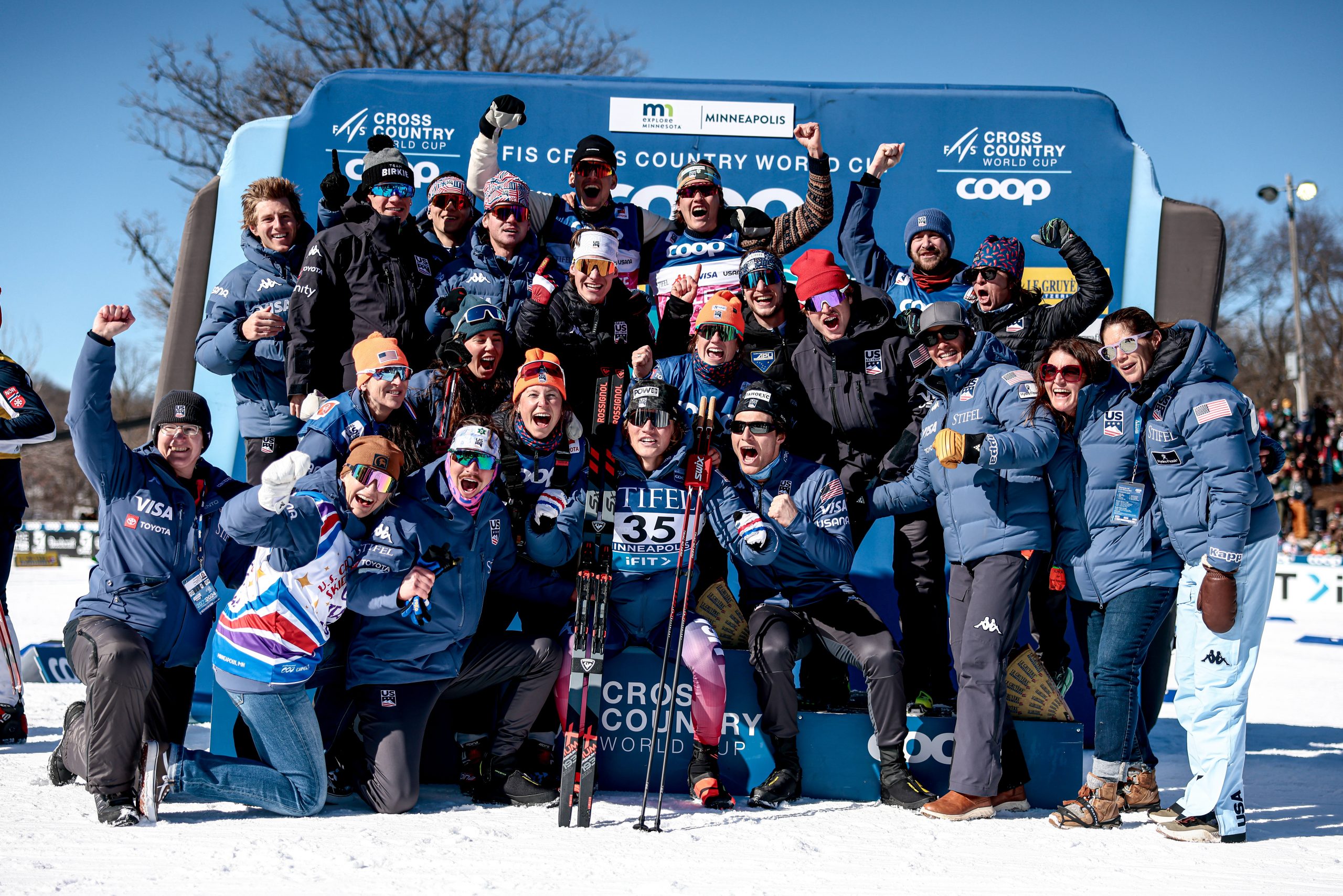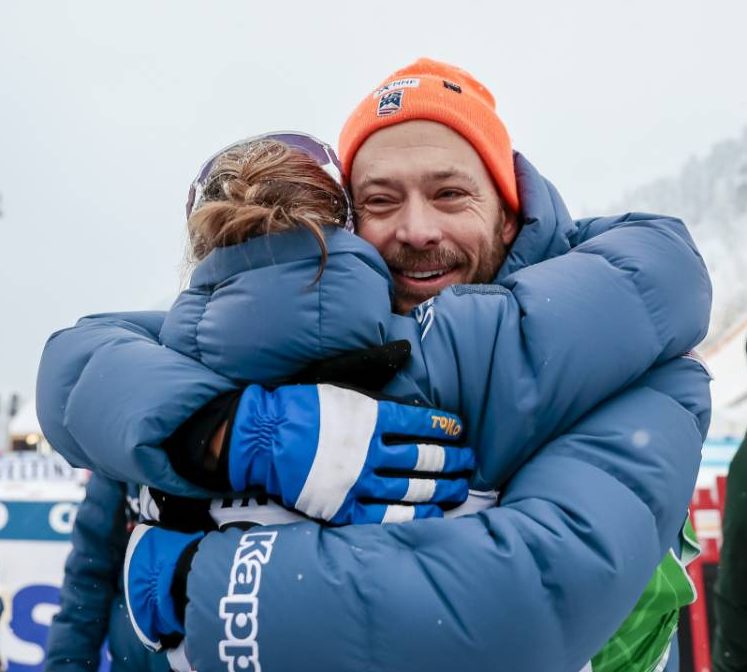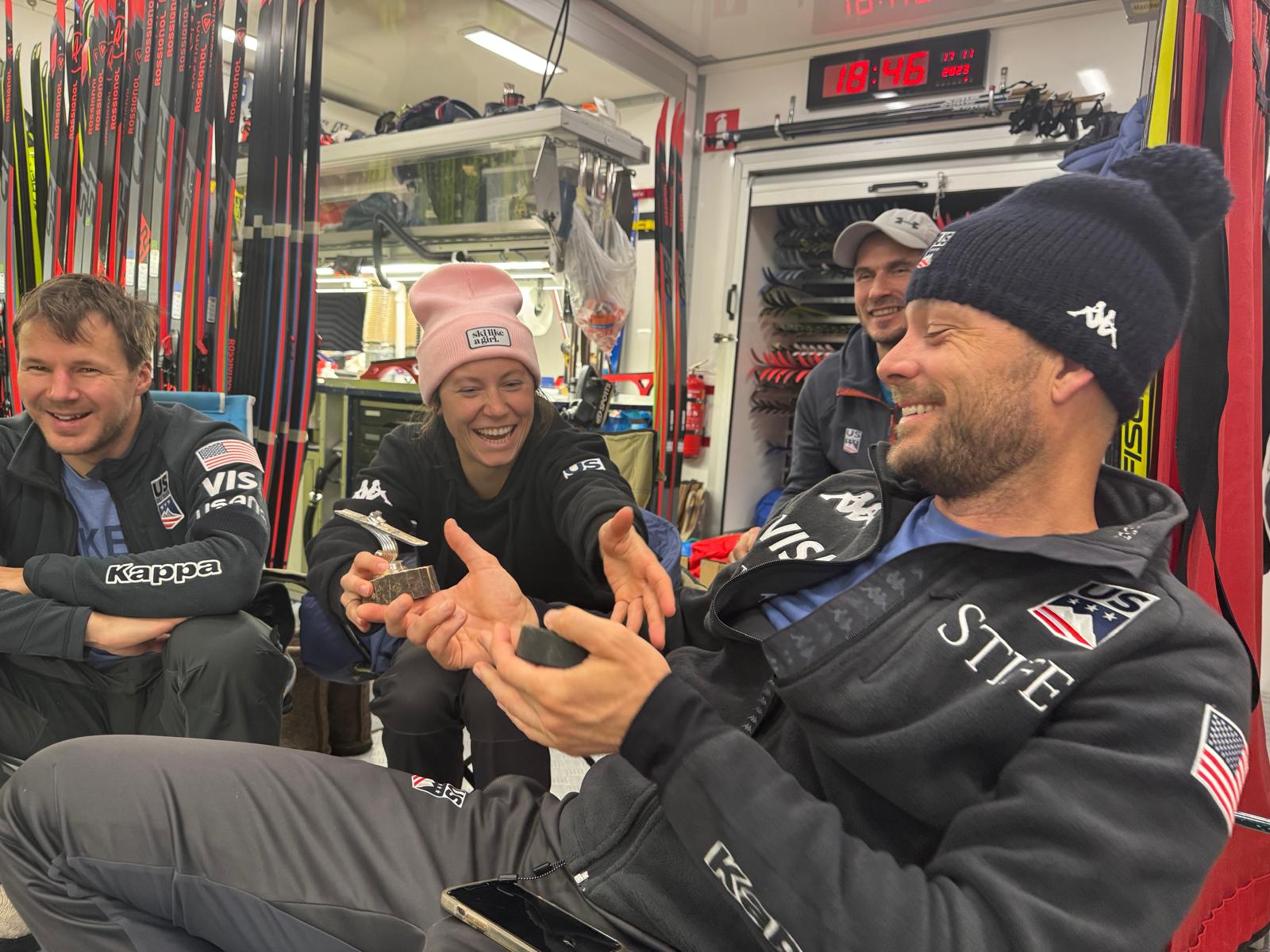
Asked for a reflection on the 2023-24 World Cup season, US Ski Team Head Coach Matt Whitcomb pointed straight towards one place; Theodore Wirth Park in Minneapolis, Minnesota, on a sunny February day, filled to the brim with 20,000 people cheering loud and clear.
“We often talk about athletes peaking for big events,” he said. “But I’d never considered that our American ski culture could peak for an event.”
The specific dynamics between performance and culture may be something Whitcomb is ongoing in noting, but his reflections on this World Cup season show a clear comfort operating in the connected space between the two. In a season of many notable triumphs for American skiers, Whitcomb can trace each individual achievement to a team philosophy shared between each US Team member, extending from their roots in ski communities across the country.
In Jessie Diggins’ Overall World Cup title, Rosie Brennan and Sophia Laukli’s World Cup podiums and victories, JC Schoonmaker and Ben Ogden’s first World Cup podiums, Junior World Championship and Youth Olympic Games medals and, yes, that special Sunday in Minneapolis for Gus Schumacher, Whitcomb sees a consistent ethos. Put together in a single sentence, it’s hard to believe that all those things happened in just the last five months, and as our conversation with Matt Whitcomb shows, this one burst of success is reliant on a consistent thoughtfulness, put into athletes, development, and for the US, a ski community spanning a continent, in which he is a clear leader.
This interview has been edited for length and clarity.
Ben Theyerl/FasterSkier (FS): We last caught up with you ahead of the North American World Cups. I was re-reading that interview, and was struck just by how many of the through-lines you traced in the development of US Skiing and a US Team culture shone through the overwhelming success of the Minneapolis World Cups.
Things like “I want to stand along the course and see and hear what 10,000 people [feel like],” and “We made a goal this year as a team: stop taking podiums for granted. This year, you see us storm the podium and take a team photo with the one athlete who actually earned the award” look a little different when you know there were 20,000 people there, and what it looked like to celebrate Gus Schumacher winning his first World Cup at that World Cup.
How do you look back on that weekend in Minneapolis and what it meant for the US Ski Team?
Matt Whitcomb (MW): I just feel grateful and lucky, so I’d like to say thank you to everyone in the U.S. cross country ski community, and especially to those who traveled to Canmore or Minneapolis. We often talk about athletes peaking for big events, but I’d never considered that our American ski culture could peak for an event. We shocked the visiting nations, and I’m just so proud of it all. A big thanks to Claire Wilson, Doug DeBold and everyone at The Loppet Foundation, including the hundreds of delightful volunteers who ran the event of a lifetime. This World Cup was very expensive, so thanks, too, to The Loppet Foundation, U.S. Ski & Snowboard, Share Winter, the event sponsors, the vendor tents and trucks, and those who chipped in from the grassroot level when the funds were tight.
“If you build it, they will come.” And they did.
FS: There was a lot more to celebrate back in Europe at the end of the season as well. Jessie’s Crystal Globe, of course, and then also a second consecutive year taking fourth place in the Nation’s Cup, which you’ve highlighted as being a very big deal for the team in the past.
When the last ski had been waxed, and the last athlete crossed the finish line this season, what struck you initially about what made this year special for American skiing?
MW: The first thought was one of dread: The staff relay starts in five minutes! When that was finally over, and I was on my flight out of Stockholm, I was thinking about how many American athletes raced a World Cup this season. I believe the number stands at 40, and 7 of them stood on 22 podiums.
We were fourth in the world as a team, losing to Finland by a painfully small margin on the last day of the season. Our women finished the season in third, and our men finished in fifth, when we moved ahead of Italy on the final day. If you look beyond the World Cup too, it was a phenomenal season for US Skiers; we had a podium at the Youth Olympic Games, one at World Juniors, and two at U-23 Championships.
I get more excited about the reasons behind the results than I do about the results themselves, and I’m proud of the club system we’ve all built in this country. We are a decentralized national team, which means we don’t bring the athletes to live in Park City, Utah as soon as they make the team. Instead, the clubs and the national team work together to build a team around each athlete that covers the whole year. It feels good to see that working.

FS: As you’ve had a little time to reflect, are there any other aspects of this season that have risen to top-of-mind as being clearly special? Maybe it was a specific performance, or a particular principle that really shone through about this year’s group…
MW: Take a look at our three men’s podiums. Also, re-read that sentence! In each instance, there was a special sort of human connection, which ultimately points to the fact that our success requires so much more than just good training.
- JC Schoonmaker toes the line in the skate sprint final in Östersund, Sweden. Five minutes earlier, he watched his girlfriend, Emma Ribom, win the women’s race. And not only that, his brother and teammate, Ben Ogden, is in the heat with him. They have something to defend. A mission. There’s some fuel to burn, and he finishes third, Ben fourth. This was JC’s first podium, and our first men’s podium in seven years (dating back to Simi Hamilton’s 2nd place in Toblach in 2017).
- Ben Ogden makes the podium in Toblach, Italy, just three weeks after watching JC break the barrier for our men’s team. There’s a different vibe now: We’ve transitioned from knowing we could do it, to doing it. Our young men’s team has come alive, and Ben is at the center of it today. He and his boys are building something together, and today, he intends to showcase it. And in the crowd, hanging over the fence at the top of the last climb, is his mom, his sisters, his girlfriend, all there to support him in what has been the hardest year of his life. He finishes third, and lands on his first career podium.
- Gus Schumacher starts bib 35, and heads out on the 3.3k loop in Minneapolis, which is a tunnel of 20,000 Americans, who have essentially created a particle accelerator loop for our skiers. With a reasonably low bib number, his “race leader” splits are somewhat empty, as he knows he should be winning at this point, because the big boys are yet to start. And Gus is now the target. One by one, the rest of them start and are clear of 6.6k. Gus is still the leader, but nine men know that he is only eight seconds ahead of them, and it will be nearly impossible for him not to be overtaken…unless you were there, and you heard how American fans support their skiers. It was actually impossible for him to be beaten. If you saw Gus’s final 2k in Minneapolis, you saw something special. This wasn’t just about a lot of smart preparation and grit. You saw what inspired skiing looks like, which happens when there is something to ski for.
FS: Five months is a long season, so this is intentionally a kind of absurd question: is there a single moment that sticks out to you as having been an especially good distillation of this season for the US Ski Team?
MW: This jumped out immediately. One of our Trail to Gold coaches during the last part of the World Cup season, Julia Hayes Forbes, had a birthday while we were in Oslo, so we all met at the wax truck, affectionately nicknamed Yolanda, before dinner to celebrate, and basically regroup for the final week of Drammen and Falun. We were a tired staff. We had not had the best two weeks of racing, and the pressure was now very high. In Yolanda, our staff has a few trophies we pass around when someone feels like acknowledging exceptional work. I won’t get into the bylaws that govern how the primary, back-up, and secret trophies are awarded, but this night, for two hours, we sat in a camp-chair circle and took turns celebrating each other. We dug in deep for two hours, tossing the back-up trophy—which is a hockey puck—from this person to that. We laughed a lot. There were some tears, too, because we all took the chance to slow down and appreciate each other. We felt lucky, and that was it.
Two days later, Rosie hits the podium in Drammen. She was back. We were all back.

FS: A lot of us who work as coaches are into feeling that post-ski season haze and relief and are curious for you, What do you do to get yourself some rest after the season? Is there a point each spring where you start to get really excited about re-convening with the US Team in Bend?
MW: I always expect my first couple of weeks back from the season to be relieving and restful, but in truth, it’s a tough time of year for me. Coaches have the wonderful job of feeling purposeful, and being required to ski as a profession. We’re goal directed, and each weekend we get to test our progress against those goals. Suddenly that’s gone, and we’re supposed to decompress with time away from it all, and it’s hard for me. We do our planning in early April, and that’s when I start to get excited again. I do miss the team and our staff, and I have a lot of unaccomplished goals yet to meet, so it’s been fun to get back to work.
In terms of what I do, I spent 10 days in Austin and New Orleans with my girlfriend, Caitlin, going on ghost and gator tours, eating everything, including gator. Before Bend, I’ll get out to a Lake in Nevada with my brother, Jake, and former ski racers, Cam MacKugler, and Hunter Karnedy, for a few days of fishing.
FS: Last time we talked with you, you emphasized how “[building and maintaining a great team environment] will always be my number one focus,” and pointed to the group of US Women who really elevated US Skiing to its current run of historic results that started in the 2010s with Kikkan Randall, Holly Brooks, Liz Stephen, Jessie Diggins etc…
How have you observed that great team environment evolve over the last couple of years, especially as there’s been a couple different groups of young skiers – first Ben Ogden, JC Schoonmaker, Gus Schumacher, Luke Jager, Julia Kern, Novie McCabe, and Sophia Laukli, and now John Steel Hagenbuch, Zanden McMullen and Sammy Smith, among others, join and find World Cup success?
MW: We had some great years during the second half of the Kikkan era, and while all but Jessie and Rosie have moved on from ski racing since those days, the expectation of what it means to be a member of the U.S. Ski Team is as clear as it ever was. Each skier and staff member has a responsibility to the team. The return one gets from that investment is one of the keys to a great career. I think that’s the legacy of those skiers from 2006-2018. As we all expected, the young American men’s squad from the Goms, Oberwiesenthal, and Lahti World Junior Championships have arrived. Given the nature of their success as three-year relay medalists, we didn’t just expect to receive fast skiers, and we figured they were going to be pretty invested in the team element of cross country skiing, too. To have that is critical. We’ll go backwards if we ever lose it.
FS: Finally, well there’s still snow on the ground (even in New England!) and memories of the season are still fresh, here’s a way to early question: what hopes do you have for the Stifel U.S. Ski Team as it looks towards 2024-25?
MW: We are trying something different this year, which is to travel less in the summer. We will have big camps in Bend, Oregon in May and in Park City, Utah in October, but for June, July, August, and September, the emphasis will be on stable training at home, really leaning into the club system. We’ll have small projects inNew Zealand and Norway, and coaches will make some club visits, but most skiers will travel less, and I’m excited to test this new plan.
The goal for the next year is to have success in Trondheim at the World Championships, and those championships come very late in the winter compared to previous World Championships, February 26th-March 9th. To succeed there, we need stability. And of course, as a team we plan to break our two-year pattern of being fourth in the World. We want that top-three badly.
FS: You mentioned that April ends up being the time for “planning” for next season and beyond for you, and for all of American skiing. You also implicitly mapped out where that planning pays off – the guys that were medaling at Junior World Championships a couple of years ago worked persistently and diligently, and got the support they needed, and now JC, Ben, and Gus all have been on World Cup podiums.

When you look at translating the developmental success US Skiing had this year into that next generation of World Cup podiums, where are you looking?
MW: I don’t think most people realize that we are the only team in the top-10 in the World who doesn’t receive government funding. That’s why you hear us asking for money every year. Each year, the U.S. Ski Team invests over a million dollars in our cross country program. That money comes from sponsors and partnerships, and from private donations. It is spent largely on our A and B Team athletes, and the coaches and techs that run the team. The National Nordic Foundation, on whose board I serve, raises money exclusively from private donations. We invest in the athletes below the A and B Team level, down to the U-16 level, to ameliorate the financial barriers of our development system. While that amount invested in our younger athletes varies from year to year, it has hovered around $350,000 for each of the last three years. Every development camp in the U.S., including U-16, REG, NEG, and NTG are subsidized to the tune of about 70k by these funds. We invest 23k in the SuperTour hosts, so they can afford to organize the races, and 28k in our Trail to Gold women’s coaching grant, to close the gender gap disparity in elite coaching. 47k has just been sent to the 26 World Cup athletes who are not A or B Team athletes, but who still earned World Cup starts.
So, when you hear about the NNF’s online auction in July, or our Drive for 25 in November, or some scheme to sell athlete bibs or hats for an event, this is why. We truly need your help. We are working hard for the athletes, so they can afford to participate in our great sport. There are over 2,000 people who donated to the NNF in some way last year, and I’d like to end this interview as it began, with a thank you.

Ben Theyerl
Ben Theyerl was born into a family now three-generations into nordic ski racing in the US. He grew up skiing for Chippewa Valley Nordic in his native Eau Claire, Wisconsin, before spending four years racing for Colby College in Maine. He currently mixes writing and skiing while based out of Crested Butte, CO, where he coaches the best group of high schoolers one could hope to find.



